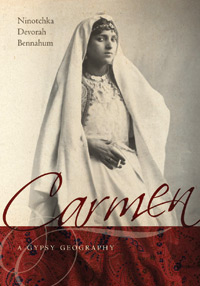New Book on Carmen by UCSB Faculty Member
Dance Historian Ninotchka Bennahum Pens Carmen: A Gypsy Geography
A ballet dancer from the deserts of New Mexico and a reader and writer with a vivid imagination, Ninotchka Bennahum developed a fascination with the art of flamenco early in life. In Albuquerque and Santa Fe, she watched riveted as world-class bailaoras demonstrated a form of dance at once related to and wildly different from Bennahum’s classical training. In their bodies she saw a fusion of East and West, of male and female: arms lifted and torso rising, while bent knees and stomping feet grounded the lower body. In the middle were the hips, swaying, circling, thrusting, undulating, so unlike their stillness in classical ballet.

Bennahum’s interest led her to New York for a doctorate in performance studies, then to Spain, where she continued to pursue flamenco as both a practitioner and appreciator. In Europe, she also met Middle East scholars who spoke to her of nomadic gypsy culture, Orientalism, and deserts not unlike those of her childhood.
Years of study later, Bennahum’s lifelong absorption in Islamic Spain, flamenco, and gypsy culture has culminated in a book: Carmen: A Gypsy Geography, published earlier this year by Wesleyan University Press. The author, who’s also a UCSB associate professor of dance history, will hold a free public event next Tuesday at Granada Books to discuss the captivating figure of Carmen. (Full disclosure: This writer will moderate the Q&A session.)
Carmen is perhaps best known in our culture as the tragic heroine of the 1875 Bizet opera, as a fiery gypsy dancer who seduces the simple soldier Don José, leaves him for a dashing bullfighter, and meets her end at the bullring, where Don José stabs her to death in a rage of jealousy. Before she was the centerpiece of the world’s most popular opera, Carmen was the protagonist of a racy novella written by French author Prosper Mérimée, inspired by a story he read in the news of a gypsy woman murdered by her lover for her adultery.
For Bennahum, Carmen is less a single character or an actual woman than she is a symbol — a cipher, Bennahum calls her — representing the unfettered female artist, feminine sexual power, and the fear and violence such an image engenders.
“Her story is passionate and erotic,” Bennahum explained over the phone last week. “It’s about banditry and migration, Moors and Christians, dark and light, south and north, laws and lawlessness — all carried inside Carmen. Because of this, she’s scapegoated and ritually sacrificed throughout history. The ritual sacrifice of Carmen becomes a sacrifice of female empowerment.”
Rather than trace the image of Carmen chronologically, Bennahum arranges her book according to themes and cultures — thus the subtitle A Gypsy Geography. We travel first to Mérimée and Bizet, then back to ancient mythology, forward again to gypsy culture, and then to Picasso, an artist who returned over and over to the image of Carmen. It’s a wide-ranging journey across great expanses, as Bennahum acknowledges in the book:
“What is gypsy geography?” she asks. “It is a moving architecture, a theater of nomadology, a borderless stage that spills into Spanish history …”
In conversation, Bennahum elaborated on the idea of the book as mirroring a nomadic journey, and of the dancer as embodying such a journey.
“I always felt dancers were living, moving mobile archives — libraries, basically — holding the migrational patterns of gypsies and flamenco. At moments, that dance is sacred and spiritual; at others, it’s fierce, resistant to colonialism and persecution.”
While it’s easy to think of Carmen as a symbol of female power, Bennahum reminds us that she’s simultaneously an incredibly vulnerable figure, and that that duality is evident in the form of flamenco itself. As she described “… the Western/Eastern duality of the body, feet pressing down, the broken line of the hip, the extension of the arms into space, the ritual repetition of 15 or 20 minutes until the dancer leaves the present world and journeys as if mounted by spirit …” Bennahum herself seemed to be transported, her voice speeding until she was slightly breathless. “Carmen is spirit, and that is why Don José can’t have her, and why she cannot be had,” the author concluded. “She is as delicate as any work of art can be.”
4•1•1
Ninotchka Bennahum will discuss Carmen: A Gypsy Geography with Independent dance writer Elizabeth Schwyzer at Granada Books (1224 State St.) on Tuesday, December 10, at 7 p.m. Call (805) 845-1818 or visit sbgranadabooks.com for info.



